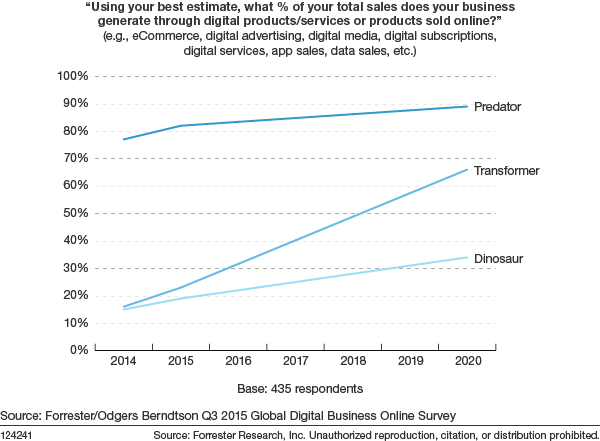The 2016 Guide To Digital Predators, Transformers, and Dinosaurs
By 2020, every company that exists today will have become a digital predator or digital prey. This isn't news to you if you follow my research or blog posts. In fact I've been saying that since 2014. But why is it that some companies seem to understand digital business more than others? Is their a difference in the leadership in digital predators compared to digital dinosaurs?
These are the questions I dig into in my latest research "The 2016 Guide To Digital Predators, Transformers, and Dinosaurs." To get at the answers, we analyzed the results from the digital business survey to tease apart companies that are already digital, those that are transforming to become more digital, and those that are remaining less digital. Examining the perspectives of business executives in each group, we reveal how the digital business DNA differes between predators, transformers and dinosaurs.
Executives At Digital Predators Are Really, Really Customer Obsessed
While all companies profess to put customers first, it’s clear from the data that executives at digital Predators care more passionately about the customer across multiple dimensions: In every customer metric we measured, these executives rated the importance of the customer higher than peers in transformers and dinosaurs – in short, they are not just customer obsessed, they are really, really customer obsessed. Nowhere is this clearer than in the perception of how to apply digital thinking to the business:

Predators understand how to use digital to create customer value. Predators stand out for having a business strategy in place that shows how the business will leverage digital to create new sources of value for customers. These companies understand the connection between digital experiences and the customer’s perception of the value the company creates. It is this understanding that differentiates predators from other companies; these companies use digital assets to drive revenue by helping customers achieve outcomes. For example, Tesla understands it’s customers prefer to use their cars and not take their cars to be serviced; Tesla does everything it can, including automatic software downloads that change the car’s systems, to avoid having the customer bring a car in for service – contrast this to the typical car dealer that makes their profits from service and repairs. Tesla is rewriting the auto-industry rule book using technology to help its customers. By contrast, Transformers, and Dinosaurs are much more likely to see digital as a way to enhance the firm’s existing business model, without fundamentally changing how the firm creates value for customers or drives revenue.
To learn more about the differences between predators, transformers and dinosaurs download the report. (This report is part of the digital transformation playbook for 2016).
Previous Post: Digital Transformation 2016 infographic
Next post: One Million Thanks